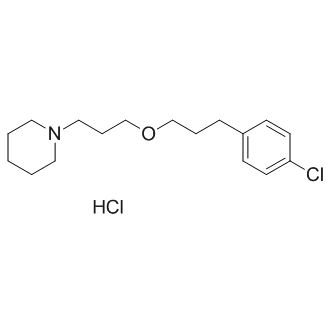| Cas No.: | 903576-44-3 |
| Chemical Name: | 1-(3-(3-(4-Chlorophenyl)propoxy)propyl)piperidine hydrochloride |
| Synonyms: | BF2.649; BF2649; BF-2649; BF2649; FUB-649, FUB649, FUB 649, BF2.649; BF 2.649; HBS-101; HBS 101; HBS101; Ciproxidine; Pitolisant, Tiprolisant; Pitolisant HCl; Pitolisant hydrochloride. |
| SMILES: | ClC(C=C1)=CC=C1CCCOCCCN2CCCCC2.Cl |
| Formula: | C17H27Cl2NO |
| M.Wt: | 332.309 |
| Sotrage: | 2 years -20°C Powder, 2 weeks 4°C in DMSO, 6 months -80°C in DMSO |
| Description: | Pitolisant hydrochloride is a potent and selective nonimidazole inverse agonist at the recombinant human histamine H3 receptor (Ki=0.16 nM). |
| In Vivo: | The administration of Pitolisantat a single dose of 10 mg/kg 30 min before a single dose of Olanzapine (2 mg/kg b.w.) also significantly affects immobility time in the FST. Subsequent administration of the aforementioned drug sequence in mice statistically significantly increases the duration of immobility in comparison to the time determined in the control group in the FST. It decreased locomotor activity as well. In contrast, the results obtained in subchronic treatment after fifteen administrations of both drugs (Pitolisant 10 mg/kg b.w., and after 30 min Olanzapine 2 mg/kg b.w., and again after 4 h Olanzapine 2 mg/kg b.w.) show that the administration of Pitolisant followed by that of Olanzapine equalized the locomotor activity in mice; in comparison to the level of motility in the control group, to which only Pitolisant is administered. More importantly, this combination of drugs significantly reduces immobility time to the level obtained in the control group in the forced swim test in mice [one-way ANOVA; F (3,20)=4.226,P=0.0181][2]. Rats given Pitolisant (10 mg/kg) during the conditioning phase stayed 502±94 s on the paired texture, a value not statistically different from that of controls, indicating that Pitolisant did not support place preference[3]. |
| In Vitro: | On the stimulation of guanosine 5′-O-(3-[35S]thio)triphosphate binding to this receptor, Pitolisant (BF2.649) behaves as a competitive antagonist with a Ki value of 0.16 nM and as an inverse agonist with an EC50 value of 1.5 nM and an intrinsic activity ~50% higher than that of ciproxifan. Pitolisant displaces [125I]iodoproxyfan binding from mouse brain cortical membranes with an IC50 value of 26.4±4.5 nM. Taking into account the Kd value of the radioligand (161±9 pM), the deduced Ki value for Pitolisant is 14±1 nM. Pitolisant displaces [125I]iodoproxyfan binding from membranes of rat glioma C6 cells stably expressing the human H3 receptor with an IC50 value of 4.2±0.2 nM. Taking into account the Kd value of the radioligand (50±4 pM), the deduced Ki value for Pitolisant is 2.7±0.5 nM. Pitolisant progressively reverses this response with a Hill coefficient close to unity and an IC50 value of 330±68 nM, leading to a Ki value of 17±4 nM. Pitolisant elicits a dose-dependent decrease of the basal-specific [35S]GTPγS binding to membranes with a maximal effect corresponding to 75±1% of the basal-specific binding and an EC50 value of 1.5±0.1 nM[1]. |






















